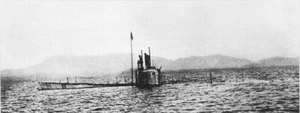
The Project 651, known in the West by its NATO reporting name Juliett class, was a class of Soviet diesel-electric submarines armed with cruise missiles. They were designed in the late 1950s to provide the Soviet Navy with a nuclear strike capability against targets along the east coast of the United States and enemy combatants. The head of the design team was Abram Samuilovich Kassatsier. They carried four nuclear-capable cruise missiles with a range of approximately 300 nautical miles (560 km), which could be launched while the submarine was surfaced and moving less than four knots (7.4 km/h). Once surfaced, the first missile could be launched in about five minutes; subsequent missiles would follow within about ten seconds each. Initially, the missiles were the inertially-guided P-5. When submarine-launched ballistic missiles rendered the P-5s obsolescent, they were replaced with the P-6 designed to attack aircraft carriers. A special 10 m2 target guidance radar was built into the forward edge of the sail structure, which opened by rotating. One boat was eventually fitted with the Kasatka satellite downlink for targeting information to support P-500 4K-80 "Bazalt" anti-ship cruise missiles. The Juliett class had a low magnetic signature austenitic steel double hull, covered by two inches (51 mm) thick black tiles made of sound-absorbing hard rubber.
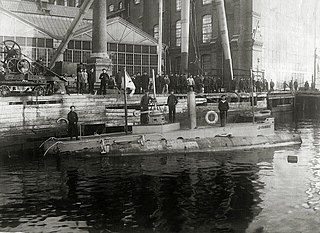
Delfin was the first combat-capable Russian submarine. She was commissioned in 1903 and decommissioned in 1917, having served during World War I. During a test dive in 1904, 25 crew were killed.

German submarine U-2331 was a Type XXIII U-boat built for Nazi Germany's Kriegsmarine during World War II and intended for service against allied shipping in coastal waters. She was a brand new, high-technology electric U-boat which was lost when only one month old in a bizarre training accident in the Baltic Sea. Built at Hamburg, she was constructed at speed, as she and her sisters were seen as war winning weapons and thus vitally important to the German war effort.

The Aréthuse class were submarines built for the French Navy in the 1950s. They were designed as attack submarines for anti-submarine warfare and were referred to as Sous-marins de Chasse by the French Navy. These submarines had advanced sensors and were very quiet. They were influenced by the World War II German Type XXIII U-boats. The Daphné class are an enlarged version built for the French, Pakistani, Portuguese, Spanish and South African navies.
The Russian submarine AG-12 was an AG-class submarine, designed by the American Holland Torpedo Boat Company/Electric Boat Company, built for the Imperial Russian Navy during World War I. The submarine was fabricated in Canada, shipped to Russia and reassembled for service with the Baltic Fleet. She was scuttled by the Russians at Hanko in April 1918.

The AG-16 was an AG-class submarine, designed by the American Holland Torpedo Boat Company/Electric Boat Company, built for the Imperial Russian Navy during World War I. The submarine was fabricated in Canada, shipped to Russia and reassembled for service with the Baltic Fleet. The boat was originally named AG-13, but was redesignated AG-16 after AG-15 sank and later repaired in 1917. She was scuttled by the Russians at Hanko in April 1918.

HMS E1 was a British E-class submarine that was built by Chatham Dockyard and cost £101,700. E1 was laid down on 14 February 1911. She was launched on 9 November 1912 and was commissioned on 6 May 1913. During World War I she was part of the British submarine flotilla in the Baltic.
HMS E10 was a British E class submarine built by Vickers, Barrow-in-Furness. She was laid down on 10 July 1912 and was commissioned on 10 March 1914. She costed £105,700. E10 was lost in the North Sea on or around 18 January 1915.
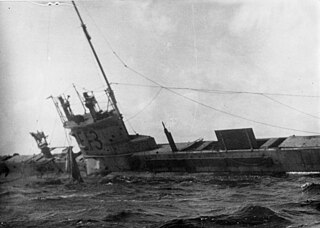
HMS E13 was a British E class submarine built by HM Dockyard, Chatham. E13 was laid down on 16 December 1912 and was commissioned on 9 December 1914. The hull cost £101,900.
HMS E22 was a British E-class submarine built by Vickers, Barrow-in-Furness. She was laid down on 27 August 1914 and was commissioned on 8 November 1915.
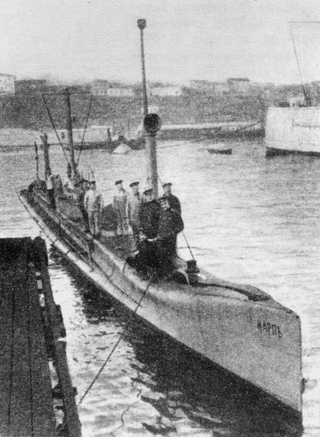
The Karp class were a class of submarines built by Krupp Germaniawerft for the Imperial Russian Navy. The class, composed of three boats were ordered in the 1904 emergency programme as a result of the Russo-Japanese War. The design was a twin hull type powered by a kerosene-electric power plant with a 16-fathom diving limit. The boats were delivered late for the war and transferred to the Black Sea Fleet by rail in 1908. In 1909, Kambala was lost. The other two submarines remained in service until their withdrawal in March 1917. They were taken over in April 1918 by the Ukrainian State before being captured by the German Empire in May and transferred to the British following the German surrender in November. The British scuttled Karp and Karas in 1919 to prevent their capture by the Soviets.

The Morzh-class submarines were built for the Black Sea Fleet of the Imperial Russian Navy shortly before World War I.

The U-1 class was a class of two submarines or U-boats built for and operated by the Austro-Hungarian Navy. The class comprised U-1 and U-2. The boats were built to an American design at the Pola Navy Yard after domestic design proposals failed to impress the Navy. Constructed between 1907 and 1909, the class was a part of the Austro-Hungarian Navy's efforts to competitively evaluate three foreign submarine designs.

SM U-1 or U-I was the lead boat of the U-1-class of submarines or U-boats built for and operated by the Austro-Hungarian Navy. U-1 was designed by American naval architect Simon Lake of the Lake Torpedo Boat Company, and constructed at the Navy Yard in Pola. She was one of two Lake-designed submarines purchased as part of a competitive evaluation of foreign submarine designs after domestic proposals were rejected by the Navy.
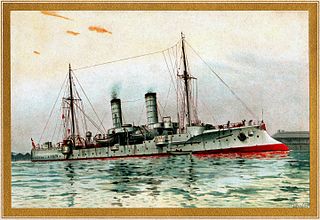
The Gazelle class was a group of ten light cruisers built for the Imperial German Navy at the turn of the 20th century. They were the first modern light cruiser design of the Imperial Navy, and set the basic pattern for all future light cruisers in Imperial service. The design of the Gazelle class attempted to merge the fleet scout with the colonial cruiser. They were armed with a main battery of ten 10.5 cm (4.1 in) guns and a pair of torpedo tubes, and were capable of a speed of 21.5 knots.

SMS Augsburg was a Kolberg-class light cruiser of the German Kaiserliche Marine during the First World War. She had three sister ships, SMS Kolberg, Mainz, and Cöln. The ship was built by the Kaiserliche Werft in Kiel; her hull was laid down in 1908 and she was launched in July 1909. Augsburg was commissioned into the High Seas Fleet in October 1910. She was armed with a main battery of twelve 10.5 cm SK L/45 guns and had a top speed of 25.5 knots.
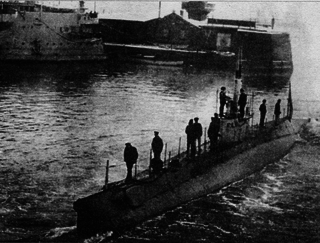
The Russian submarine AG-11 was an AG-class submarine, designed by the American Holland Torpedo Boat Company/Electric Boat Company, built for the Imperial Russian Navy during World War I. The submarine was fabricated in Canada, shipped to Russia and reassembled for service with the Baltic Fleet.

The Russian submarine AG-22 was an AG-class submarine, designed by the American Holland Torpedo Boat Company/Electric Boat Company, built for the Imperial Russian Navy during World War I. The submarine was fabricated in Canada, shipped to Russia and reassembled for service with the Black Sea Fleet. Her reassembly was completed in 1919 by the White Movement during the Russian Civil War, and she joined Wrangel's fleet as it evacuated the Crimea in 1920 and was interned in Bizerte, Tunisia in 1921. AG-22 was abandoned there and subsequently scrapped.

K-43 was a Charlie-class nuclear-powered cruise missile submarine operated by the Soviet and Indian navies. It was built between 1964 and 1967 and was commissioned into the Soviet navy on 5 November 1967. It later served as INS Chakra in the Indian Navy from 1988 to 1991.

K-70 was a "Project 651" diesel–electric submarine built for the Soviet Navy during the 1960s. Commissioned in 1965, the boat was armed with long-range cruise missiles to carry out its mission of destroying American aircraft carriers and bases. The missiles could be fitted with either conventional or nuclear warheads. K-70 was initially assigned to the Northern Fleet, but was transferred to the Pacific Fleet a few months later. The submarine was decommissioned in 1989 and subsequently scrapped.
